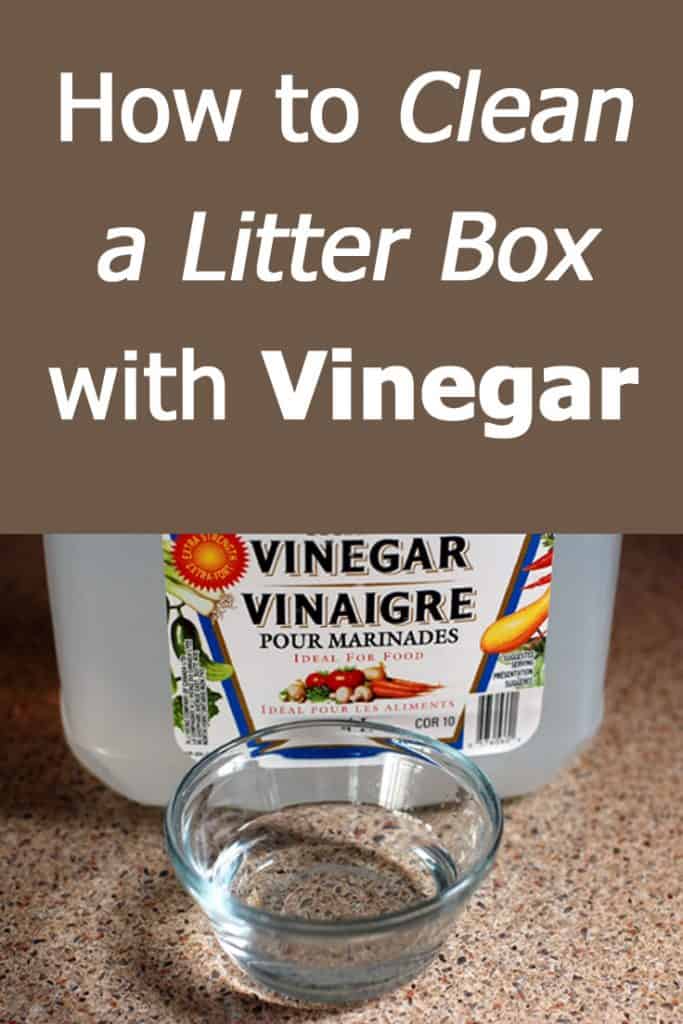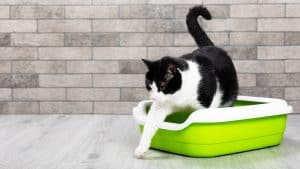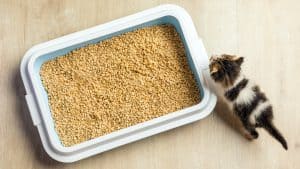Many cat owners prefer to keep their homes free of complex synthetic chemicals. They look for simple and more affordable natural solutions with vinegar being a popular choice. With so many sources touting the benefits of this natural substance, the question seems inevitable: How to clean a litter box with vinegar?
After all, vinegar is an affordable product that you can buy in the food aisle. It's a weak acid that's safe enough for humans to consume by eating. While cats shouldn't digest it, you can certainly clean a litter box with vinegar.
In this article, we'll talk about the effectiveness of vinegar as a cleaning solution, about cleaning the litter box, and of course, the cross-section of the two topics: How to clean a litter box with vinegar.

Vinegar as a Cleaning Solution
What Is Vinegar?
You probably have a bottle of vinegar sitting in your cupboard right now, but have you ever wondered what it is? Vinegar is primarily made with ethanol alcohol that is fermented. There are also flavor compounds, minerals, vitamins, and acetic acid.
The “mother of vinegar” culture, as it’s called, is a type of fermenting bacterial culture that is used in making vinegar. This can sometimes leave a slimy residue in a vinegar jar though, which is why many manufacturers will pasteurize the vinegar first. This eliminates the mother culture’s unappealing sliminess.
If you’re wondering if you can use old vinegar to clean your cat’s litter box, you probably can. As long as the vinegar is stashed in a room-temperature environment and the lid or cap is tightly closed, it’s usable.
Vinegar takes much longer to go bad and grow bacteria due to its acidity. You only have to worry if you have unpasteurized vinegar, as bacteria can grow. It will often be a big, sticky, blob. To control the bacterial growth of unpasteurized vinegar, keep it in the fridge.
What Types of Vinegar Do People Use for Cleaning?
There are many types of vinegar out there, everything from coconut to beer vinegar as well as raisin, cane, malt, rice, balsamic, and wine vinegar. Most of these should only be used for cooking, though, and not cleaning. Plain old-fashioned white vinegar is the preferred choice if you want to clean a litter box with vinegar.
In some instances, people use apple cider vinegar for cleaning as well. This stands out for its tannish color profile (like apple juice) and tangy flavoring. Apple cider vinegar can be consumed, although few people prefer drinking it on its own. Instead, it’s often used as part of condiments, marinades, and dressings.
It too is antimicrobial, just like white vinegar, which makes it a naturally great choice for cleaning. Apple cider vinegar can be used to clean many kitchen items, among them pots, pans, cutting boards, and even wood surfaces and carpeting.
The Pros of Using Vinegar for Cleaning
The biggest benefit to cleaning with vinegar is the wealth of items you can freshen with just a single bottle. In addition to the ones mentioned above, you can also use vinegar for cleaning:
- Your tea kettle and coffeemaker
- Jars, mugs, wine glasses, and other drinking vessels
- Your refrigerator if it’s especially odorous
- Copper, brass, and bronze surfaces, which will be freshly polished as well
- Wood scratches, which will have a minimized appearance if iodine and vinegar are mixed and applied
- Stainless steel surfaces, carpeting, and blinds
- The sink, tub, toilet, and other porcelain items
- Clothing, especially if these have yellow stains
- Your cat’s litter box
There’s more. Vinegar can also be used to refresh clothes so they smell laundry fresh while lessening wrinkles. It can eliminate hard water stains, improve the efficiency of a clothing iron, clean the interior of a washing machine, and even unclog shower and bathroom drains.
Other handy assorted uses include thoroughly cleaning scissors so they stop sticking and removing bacteria from computers, tablets, smartphones, video game controllers, and other electronics.
In addition to its many uses, vinegar is also inexpensive, which is another pro. It has a short ingredient list comprised of just acetic acid bacteria, fermented ethanol, and water. You can feel safe using it knowing that you’re not exposing your cat to any potentially dangerous chemicals when you clean their litter box.
The Cons of Using Vinegar for Cleaning
The acidity of vinegar can sometimes ruin some items around the home, like some hardwoods and stone floors. Also, the acidity of vinegar doesn’t effectively remove stains and egg spills.
Of course, you wouldn’t have any eggs near your cat, so that’s not applicable. The only issue with your feline friend might be that they won’t love the smell, especially if you use apple cider vinegar.
If that’s the case, then it’s recommended you either switch to white vinegar or dilute the vinegar solution with neutral water when cleaning.
How to Clean a Litter Box — An Overview
Why You Should Clean the Litter Box
Cats are generally self-sufficient animals. They clean themselves, entertain themselves, and relieve themselves in their litter box. Even though your cat doesn’t require as much care as say, a dog, you should still do your kitty pal a favor and clean their litter box.
Why? Most cat litter will absorb poop and pee, masking these odors so you don’t have to smell them. If fecal matter adheres to the side of the litter box, though, your home or apartment is going to quickly reek. This won’t take days, but rather only a few hours.
You want a clean home as much as your cat does. For sanitary reasons and for the health of yourself, your loved ones, and your cat, keep the contents of the litter box clean by scooping daily. Don't forget to clean the litter box itself too.
How Often Should You Clean the Litter Box?
We have thoroughly discussed this in our article titled - surprise, surprise - How often should you clean a litter box. Let's recap some of the essentials.
The type of litter box you have will determine how often you need to clean it. Essentially, though, you should do this job twice a day. This is the sweet spot in terms of pee and poop smell. That terrible odor will only get worse the longer it stays in the box, as mentioned, so the sooner you get to it, the better.
Keep in mind there are extenuating circumstances that may mean you have to clean the litter box more or less often. Your cat may be picky and insist the box is clean after their do their duty every time.
You may have several litter boxes (more on this in a moment), which gives you more leeway in how often you clean. You should only have to change the box one time each day.
If you have several cats, you can expect to ramp up that number. You might have to empty the box three, four, or more times daily depending on the number of cats.
Again, refer to our detailed guide about the right frequency for cleaning the litter box. We've covered (no pun intended) several more aspects that can help you determine how often you should clean the box.
Why You Should Have More Than One Litter Box
That’s why some cat owners prefer more than one litter box even if they only have one cat. You should follow the “number of cats +1” formula when deciding how many boxes your pet needs.
Generally, it should be at least two boxes per cat. The more cats you have, the more litter boxes you need. Since cats can’t vocalize when they need to go to the bathroom like we do, we can never be quite sure when they really need their litter box. If you happen to be cleaning the box when they need to go, they could make a mess on the floor.
By having a second litter box handy, your cat always has somewhere to do their business. You can take your time cleaning the first litter box, ensuring it’s as fresh as can be.
How to Clean a Litter Box with Vinegar
There are two ways to clean a litter box with vinegar. One uses vinegar-soaked wipes and the other one involves soaking the entire box in a diluted vinegar solution.
Before we explore both methods, keep in mind that you should try and prevent any smells from lingering in or around the box. Whether soaking the entire thing or just wiping it off, make sure you use neutral water to thoroughly remove traces of vinegar. Don't forget that a feline nose is more sensitive than the human equivalent. Use plenty of water to remove the vinegar.
If you're here asking about how to clean a litter box with vinegar, this is probably your first time doing so. In that case, clean one box at a time. Try to clean just one of your litter boxes with vinegar while the other box doesn't come into contact with the stuff.
That way, should there still be some smell and it happens to trigger litter box aversion, your cat will still have an alternative. An alternative that is not your rug or bed, that is.
Cleaning with Vinegar-Soaked Wipes
If you’d rather use vinegar-soaked wipes instead of vinegar straight from the bottle, you can. Medline’s ultra-soft disposable dry cleansing cloth wipes are a great choice for your litter box. These are highly rated and known for their absorbency, strength, and softness.
The cloths do not come with any vinegar on them, so you’ll have to put some in a spray bottle and apply it to the cloth before cleaning. This product on Amazon can do the trick.
Let the litter box sit for a minute and then soak a second clean cloth with neutral water. Wipe down all surfaces of the litter box, making sure you cleaned off all the vinegar.
If you still smell vinegar after using the second cloth, it might be worth it to wipe down the litter box again with yet another clean cloth.
Soaking the Box with Diluted Vinegar Solution
Another way you can clean a litter box with vinegar is to soak the box. First, you want to find a container large enough to fit the litter box with some room to spare. Fill that container with a diluted vinegar solution, which should include neutral water.
Leave the litter box to soak for a couple of minutes. Then take the box out and wash it with warm neutral water, making sure there is no vinegar residue left over.
Safety first
No matter which method you choose, stash the litter box in a room with good ventilation while it soaks or sits. You should also always use neutral water (not seltzer) to clean away all traces of the vinegar after cleaning.
Alternatives to Cleaning the Litter Box with Vinegar
What Do People Use to Clean the Litter Box without Using Vinegar?
Whether you don’t have any vinegar on hand or you just want to know other methods of cleaning your cat’s litter box, you have options. There are plenty of cat lovers like you across the Internet who have tried various other vinegar-free methods. These include:
- Wrapping an empty trash bag around a large container and then filling said container with cat litter (as seen on Reddit).
- Using stainless steel pans for easier cleaning and less odors (also seen on Reddit in a separate post).
- Using dish soap like Dawn, as seen on TheCatSite forums. Other methods recommended in this thread include allowing the litter box to sit and soak in a solution of hot water, laundry soap, or bleach overnight for a truly deep clean.
- Buying cheap litter boxes for about $5 per box and tossing these out weekly or monthly, as seen on this forum. Other posters suggest replacing the litter box every year to prevent too many unsanitary smells.
- Lastly, the posters on this forum recommend shelling out a bit more money for a self-cleaning litter box. While it was reported that these self-cleaning bots can make a lot of noise (including in the middle of the night), many people who have more than one cat said this was their favorite option.
More on These Methods
Let’s talk more about some of these methods. The first one we’ll start with is the simple hack of wrapping a trash bag around a container and then filling the container with cat litter.
It’s recommended you line the bottom of the litter box with newspaper so your kitty doesn’t tear through the thin plastic of the trash bag right away. Of course, if they get creative and scratch the sides of the litter box, they will easily rip through the bag.
You may have to change the litter box more than twice each day to prevent this, but collecting the litter is easy. All you have to do is gather up the trash bag and pinch it, then dispose of the bag.
The second method you might want to try is buying a stainless steel pan like those used at restaurants. The Reddit poster who did this ran a cat shelter and said the benefits are these trays “clean extraordinarily easy; they carry zero ‘smell’ residue, they last absolutely forever, and, at about 20 bucks, they actually cost about the same as the cheap plastic ones you’d find at PetSmart.”
Lastly, there are self-cleaning litter boxes. The posters who tried these devices recommend brands like Litter Robot, Cat Genie, and Litter Maid, with the latter two getting the most praise.
Some people said they’ve used their self-cleaning bots for up to five years. One poster with 10 cats only had to worry about tossing out the litter bag on a three-day basis. Even cats that are 25 pounds and up were able to use the self-cleaning litter box without difficulty.
How to clean a litter box with vinegar - final words
If you're considering cleaning a litter box with vinegar, we hope this article helped you with some pointers.
Do you already use vinegar to clean a litter box? Care to share your own tips on this matter? Just leave us a comment and let us know how this natural method works for you.



